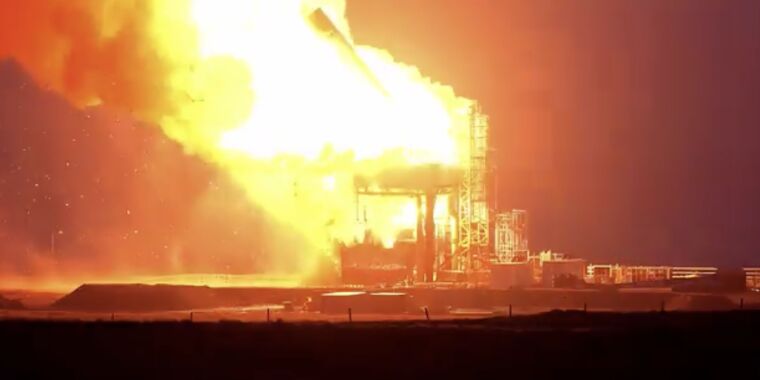Welcome to Edition 7.09 of the Rocket Report! When will SpaceX launch the next test flight of Starship? It certainly doesn’t look to be imminent, with SpaceX ground teams in Texas feverishly working to beef up the launch pad in preparation for an attempt to catch the rocket’s massive Super Heavy booster when it returns to the launch site on the next flight. Meanwhile, the FAA is reviewing SpaceX’s proposal to recover the booster on land for the first time. And on Thursday, a NASA official monitoring SpaceX’s Starship effort said the next test flight was scheduled for launch in the “fall,” suggesting it could be a month or more away. Also, we’ve listed the next three launches as “TBD” (To Be Determined) because SpaceX is waiting for FAA approval to resume Falcon 9 launches following a booster landing failure this week, and the Polaris Dawn mission is on hold due to an unfavorable weather forecast.
As always, we welcome reader submissions. If you don’t want to miss an issue, please subscribe using the box below (the form will not appear on AMP-enabled versions of the site). Each report will include information on small-, medium-, and heavy-lift rockets as well as a quick look ahead at the next three launches on the calendar.

Firefly has a new chief executive. Jason Kim, former head of Boeing-owned satellite-maker Millennium Space Systems, has been appointed CEO of Firefly Aerospace effective October 1, Aviation Week & Space Technology reports. Kim joins Firefly as the ambitious space transportation startup, which has raised close to $600 million from investors since its 2021 founding, looks to launch a commercial lunar lander for NASA before the end of the year. Firefly is also working on a medium-lift rocket in partnership with Northrop Grumman, with the goal of competing for missions to resupply the International Space Station and launch payloads for the US military and commercial customers.
Kim brings national security chops … At Millennium, Kim shepherded several national security space missions to completion, including Victus Nox, a responsive satellite and launch mission for the US Space Force. Millennium manufactured the satellite for the Victus Nox mission, and Firefly Aerospace successfully launched it on an Alpha rocket just 27 hours after receiving the launch order from the military. This required Millennium and Firefly to integrate the satellite with the Alpha rocket on short notice. Kim replaces Bill Weber, who left the CEO role at Firefly in July after allegations he had an improper relationship with a female employee.
New Shepard flies again. Blue Origin launched six passengers, including a NASA-sponsored researcher and the youngest woman to fly in space, on a sub-orbital trip out of the lower atmosphere Thursday in the company’s eighth crewed spaceflight, CBS News reports. University of Florida researcher Rob Ferl, philanthropist Nicolina Elrick, adventurer Eugene Grin, Vanderbilt University cardiologist Elman Jahangir, American-Israeli entrepreneur Ephraim Rabin, and University of North Carolina senior Karsen Kitchen lifted off from Jeff Bezos’ West Texas launch site on Blue Origin’s New Shepard rocket. Kitchen became the youngest woman to fly higher than 100 kilometers (62 miles), and Ferl was the first NASA-funded researcher to fly on a suborbital rocket. Blue Origin and Virgin Galactic, its competitor in the suborbital human spaceflight market, have long touted their vehicles’ ability to support human-tended research in microgravity.
Three good chutes … This was Blue Origin’s first New Shepard flight since May 19, when one of the crew capsule’s three main parachutes failed to open fully on the descent. The passengers on that flight were fine, and Blue Origin says the capsule can return safely with just a single parachute if two fail. Blue Origin said it identified the cause of the parachute issue on the May flight, but didn’t offer details other than that the investigation “focused on the dis-reefing system that transitions the parachutes from the reefed to the disreefed state that did not function as designed on one of the three parachutes on NS-25,” Space News reports.
ABL’s rocket test failure damaged ground systems. A fiery malfunction on an Alaska launch pad last month not only destroyed the RS1 rocket ABL Space Systems was preparing for launch, but also damaged some ground systems at the site, ABL said in an update posted on X. The company said a fire developed “external to RS1’s base” after the booster’s 11 engines shut down during an aborted test-firing at Kodiak Island, Alaska. The fire was fed by fuel leaks from two of the engines, and ABL’s launch team was able to use water and inert gases to suppress the fire for more than 11 minutes. But the remote launch site doesn’t have a direct water supply, and mobile water tanks ran dry, causing the fire to grow until the rocket collapsed. ABL said a majority of the plumbing and electrical connections to the launch mount were damaged, but the launch mount’s structure, flame deflector, and other equipment were unharmed.
Few details on next steps … ABL published a detailed update on its investigation into the test failure, and its openness is worth noting. Engineers found two of the engines—the ones that leaked and fueled the fire—experienced “combustion instability” during their startup sequence. ABL said it believes differences in this RS1 rocket, called a Block 2 design, resulted in a higher-energy startup than expected. The company will return its damaged ground support equipment from Alaska to a facility in Long Beach, California, for refurbishment, and ABL says its next RS1 rocket is “well into production.” But the company didn’t share any information on corrective actions or a timeline for implementing them and returning to the launch pad with RS1. ABL aims to compete with other, more established small satellite launch companies like Rocket Lab and Firefly Aerospace, but its RS1 rocket hasn’t made it far from the launch pad. ABL’s first orbital launch attempt in January 2023 ended when the RS1 rocket lost power and fell back on its launch pad.

